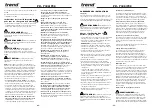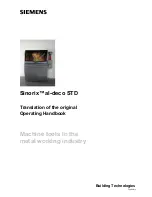
EN - T18S/TSS
EN - T18S/TSS
-9-
-8-
c) Do not expose power tools to rain or wet
conditions.
Water entering a power tool will increase
the risk of electric shock.
d) Do not abuse the cord. Never use the cord for
carrying, pulling or unplugging the power tool.
Keep cord away from heat, oil, sharp edges or
moving parts.
Damaged or entangled cords increase
the risk of electric shock.
e) When operating a power tool outdoors, use an
extension cord suitable for outdoor use.
Use of a
cord suitable for outdoor use reduces the risk of electric
shock.
f) If operating a power tool in a damp location is
unavoidable, use a residual current device (RCD)
protected supply.
Use of an RCD reduces the risk of
electric shock.
3) Personal Safety
a) Stay alert, watch what you are doing and use
common sense when operating a power tool. Do
not use a power tool while you are tired or under
the influence of drugs, alcohol or medication.
A
moment of inattention while operating power tools may
result in serious personal injury.
b) Use personal protective equipment. Always
wear eye protection
. Protective equipment such as
dust mask, non-skid safety shoes, hard hat or hearing
protection used for appropriate conditions will reduce
personal injuries.
c) Prevent unintentional starting. Ensure the
switch is in the off-position before connecting to
power source and/or battery pack, picking up or
carrying the tool.
Carrying power tools with your finger
on the switch or energising power tools that have the
switch on invites accidents.
d) Remove any adjusting key or wrench before
turning the power tool on.
A wrench or a key left
attached to a rotating part of the power tool may result in
personal injury.
e) Do not overreach. Keep proper footing and
balance at all times.
This enables better control of the
power tool in unexpected situations.
f) Dress properly. Do not wear loose clothing or
jewellery. Keep your hair and clothing away from
moving parts.
Loose clothes, jewellery or long hair can
be caught in moving parts.
g) If devices are provided for the connection of
dust extraction and collection facilities, ensure
these are connected and properly used.
Use of dust
collection can reduce dust-related hazards.
h) Do not let familiarity gained from frequent use
of tools allow you to become complacent and
ignore tool safety principles.
A careless action can
cause severe injury within a fraction of a second.
4) Power Tool Use and Care
a) Do not force the power tool. Use the correct
power tool for your application.
The correct power
tool will do the job better and safer at the rate for which
it was designed.
b) Do not use the power tool if the switch does
not turn it on and off.
Any power tool that cannot be
controlled with the switch is dangerous and must be
repaired.
c) Disconnect the plug from the powersource and/
or the battery pack, if detachable, from the power
tool before making any adjustments, changing
accessories, or storing power tools.
Such preventive
safety measures reduce the risk of starting the power
tool accidentally.
d) Store idle power tools out of the reach of
children and do not allow persons unfamiliar with
the power tool or these instructions to operate the
power tool.
Power tools are dangerous in the hands of
untrained users.
e) Maintain power tools and accessories. Check
for misalignment or binding of moving parts,
breakage of parts and any other condition that
may affect the power tool’s operation. If damaged,
have the power tool repaired before use.
Many
accidents are caused by poorly maintained power tools.
f) Keep cutting tools sharp and clean.
Properly
maintained cutting tools with sharp cutting edges are
less likely to bind and are easier to control.
g) Use the power tool, accessories and tool bits,
etc. in accordance with these instructions, taking
into account the working conditions and the work
to be performed.
Use of the power tool for operations
different from those intended could result in a hazardous
situation.
h) Keep handles and grasping surfaces dry, clean
and free from oil and grease.
Slippery handles and
grasping surfaces do not allow for safe handling and
control of the tool in unexpected situations.
5) Battery Tool Use and Care
a) Recharge only with the charger specified by the
manufacturer.
A charger that is suitable for one type
of battery pack may create a risk of fire when used with
another battery pack.
b) Use power tools only with specifically
designated battery packs.
Use of any other battery
packs may create a risk of injury and fire.
c) When battery pack is not in use, keep it away
from other metal objects, like paper clips, coins,
keys, nails, screws or other small metal objects,
that can make a connection from one terminal to
another.
Shorting the battery terminals together may
cause burns or a fire.
d) Under abusive conditions, liquid maybe
ejected from the battery; avoid contact. If contact
accidentally occurs, flush with water. If liquid
contacts eyes, additionally seek medical help.
Liquid ejected from the battery may cause irritation or
burns.
e) Do not use a battery pack or tool that is
damaged or modified.
Damaged or modified batteries
may exhibit unpredictable behaviour resulting in fire,
explosion or risk of injury.
f) Do not expose a battery pack or tool to fire
or excessive temperature.
Exposure to fire or
temperature above 130°C may cause explosion.
g) Follow all charging instructions and do not
charge the battery pack or tool outside the
temperature range specified in the instructions.
Charging improperly or at temperatures outside the
specified range may damage the battery and increase
the risk of fire.
6) Service
a) Have your power tool serviced by a qualified
repair person using only identical replacement
parts.
This will ensure that the safety of the power tool
is maintained.
b) Never service damaged battery packs.
Service
of battery packs should only be performed by the
manufacturer or authorized service providers.
Additional Safety Instructions for
Sanders
•
Always secure the workpiece by a clamping
device or in a bench vice in such a manner that
it cannot move while being machined.
•
Always wear eye protection and a respirator
when sanding.
•
Sanding of lead-based paint is not
recommended.
•
Do not operate the unit without the dust
collection bag or dust collection system.
•
Do not overload the machine by pressing with
excessive force!
The best sanding results are
achieved with moderate application pressure. The
sanding capacity and quality are mainly dependent on
the selection of the correct abrasive.
•
Clean your tool out periodically.
•
Empty dust bag frequently, especially when
sanding resin coated surfaces such as
polyurethane, varnish, shellac, etc.
Dispose
of coated dust particles according to the finish
manufacturer’s guidelines, or place in a metal can with
a tight-fitting metal lid. Remove coated dust particles
from the premises daily. The accumulation of fine
sanding dust particles may self-ignite and cause fire.
•
Replace a worn or damaged belt when it causes
high tool rpm.
High tool rpm caused by a worn-out
belt may result in separation of sanding pad from the
sander, possibly causing personal injury.
RESIDUAL RISKS
In spite of the application of the relevant safety
regulations and the implementation of safety devices,
certain residual risks cannot be avoided. These are:
• Impairment of hearing.
• Risk of personal injury due to flying particles.
• Risk of burns due to accessories becoming hot during
operation.
• Risk of personal injury due to prolonged use.
SAVE THESE INSTRUCTIONS
Electrical Safety
The electric motor has been designed for one voltage
only. Always check that the battery pack voltage
corresponds to the voltage on the rating plate. Also
make sure that the voltage of your charger corresponds
to that of your mains.
Your Trend charger is double insulated in
accordance with EN60335; therefore no earth wire is
required.
If the supply cord is damaged, it must be replaced by
a specially prepared cord available through the Trend
service organisation.
Mains Plug Replacement (U.K. & Ireland Only)
If a new mains plug needs to be fitted:
• Safely dispose of the old plug.
• Connect the brown lead to the live terminal in the plug.
• Connect the blue lead to the neutral terminal.
WARNING:
No connection is to be made to the
earth terminal.Follow the fitting instructions supplied with
good quality plugs. Recommended fuse: 3 A.
Using an Extension Cable
An extension cord should not be used unless absolutely
necessary. Use an approved extension cable suitable for
the power input of your charger (see
Technical Data
).
The minimum conductor size is 1mm
2
; the maximum
length is 30m. When using a cable reel, always unwind
the cable completely.






































